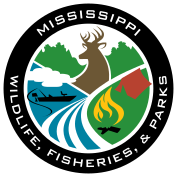
The light goose conservation order is a special hunting opportunity to help control expanding populations of snow, blue, and Ross's geese (collectively called light geese).
Mississippi offers numerous waterfowl hunting opportunities.
Overview of Waterfowl hunting opportunities by day.
The MDWFP annually partners with Ducks Unlimited, Inc. to host the Gunner Palmer Memorial Youth Waterfowl Camp.
Find information and resources to help you begin the journey to becoming an apprentice falconer.
MDWFP biologists fly aerial waterfowl surveys in the Mississippi Delta from November to January.
Although combines are becoming increasingly efficient for harvesting rice, some grain inevitably escapes and falls to the ground during harvest.
The lower Mississippi alluvial Valley (MAV), or Delta as we call it in Mississippi, once was a 22-million acre bottomland hardwood forest
Waterfowl are a diverse group of birds that include ducks, geese, and swans.
Waterfowl identification is often difficult for both new and experienced waterfowl hunters.
The following articles are from the Field Manual of Wildlife Diseases.
Here you can find an answers to common questions about falconry, including topics such as licensing, bird ownership, and recommended study materials.